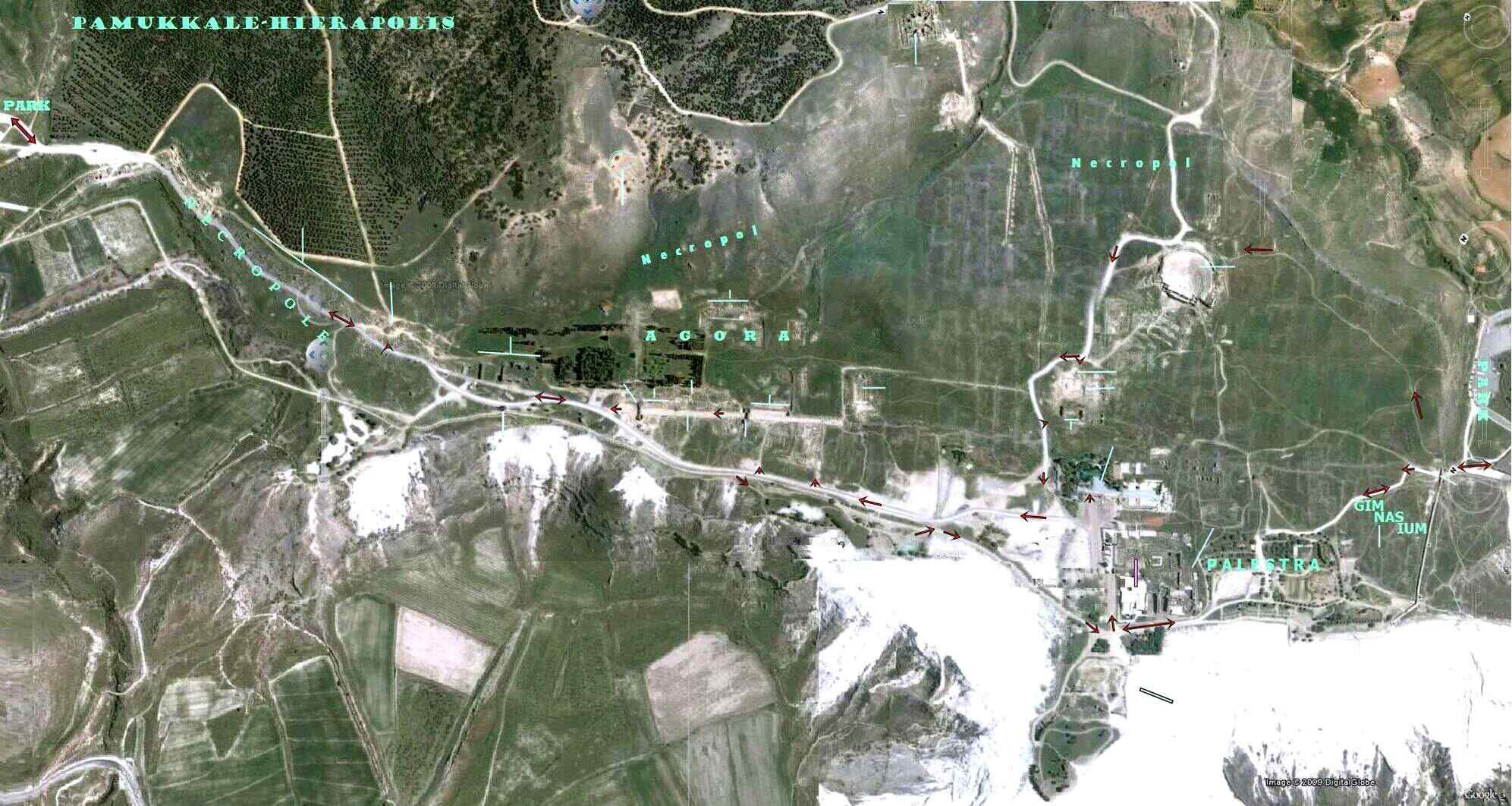

LATRINA = In the bench you find one horseshoe shaped hole per "station". Below the bench was a channel for carrying away wastes. The channel varies widely in depth from one site to the next. Immediately in front of the bench was a shallow channel carrying (relatively) clean flowing water for washing one's hands. In The interior the bench seat is missing. This provides a clear view of the rather shallow drainage channel, against the wall to the right, and the cleaning water channel immediately in front of the seats.. |
|---|
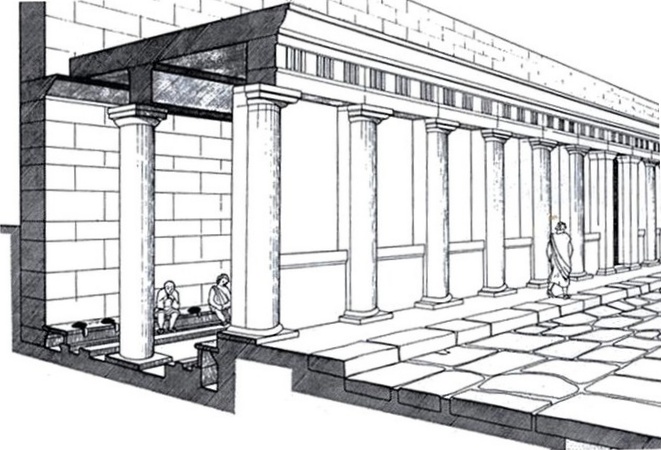 |
Stoa Basilica : East of the main street is the huge agora, the largest uncovered one discovered in the ancient world. It is 580 feet wide and 920 feet long and was surrounded by Ionic columns. To the agora's east and up a flight of steps was a large stoa-basilica, 66 feet wide and 920 feet long. This was once richly decorated with popular ancient motifs including sphinxes, lions, bulls, garlands, Eros figures and Gorgon masks.Local public meetings were also held here. Stoa Basilica Reconstruction with columns and niches decorated with statues. First storied has reliefs of floral motives.. |
|---|

TritonFountain ; The Fountain located on the main street after the Byzantine gate is considered to be the biggest in Asia Minor ( Anatolia). The structure was decorated with the relief of mythological figures, Tritons (that's why the fountain was also called Triton fountain). One of the inscriptions state the fountain was dedicated to Emperor Caracalla (211-217 AD). Two storied U plan fountain has an Corinthian order with columns and niches decorated with statues. First storied has reliefs of floral motives, and on the frieze there were relief of Amazons combating with Greeks, Griphons, Nymphs.. |
|---|
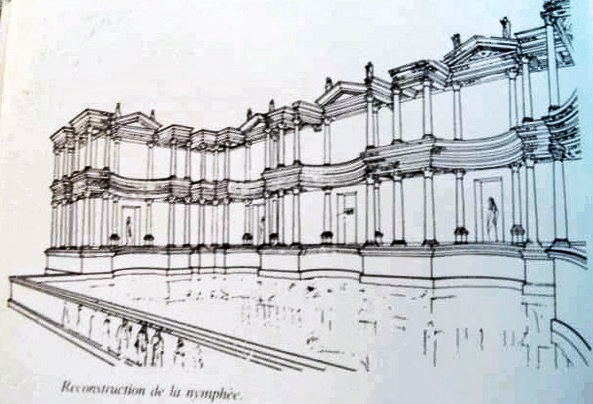 |

Necropolis: Except for the travertine area on the west, the other sides of the city are necropolis areas. Limestone and marble were used to build the cemeteries. The north Necropolis spans the time from the Late Hellenistic era to the early Christian era with sarcophagi, house-type cemeteries, tumulus-type cemeteries, and monuments . Most of them bear inscriptions on them , indicating that long before the city of Hierapolis was founded people were coming here to seek a cure in the hot springs. Those who found a cure undoubtedly returned to their own countries. But what happened to those who didn't ? They probably remained here for the rest of their lives and were finally buried here. This is the reason for this vast necropolis that occupies over a square kilometre of the ruins, and for the great variety in the types of tombs to be seen here.In accordance with ancient beliefs, a gold or silver coin or, sometimes, a coin of electrum, an alloy of the gold and silver, was placed in the mouths of the deceased to serve as a bribe to the boatman who was to ferry them over the river of Hades. In later times, tomb robbers were to find these coins embedded in the skeletons of the deceased, and, unfortunately, the tombs at Hierapolis, like those in all the other ancient cities, were pillaged by robbers from Byzantine times onward. Some tombs, however, which were completely covered by the earth, were still found to contain personal effects such as oil-lamps and tear glasses. Most of these tombs are of the sarcophagus type, The manner in which the lids are carved gives a clear indication of the region to which the deceased belonged. The fact that some of them are quite plain while others display ornately carved decoration gives some idea of the differences in social and economic status of those buried within them... |
|---|

TUMULUS : The third and less numerous category are tumulus tombs consisting of a burial-chamber covered with earth. Over the centuries some of the earth has been blown away by the wind leaving sections of the burial chamber exposed.Circular tumuli, sometimes hard to discern... |
|---|

The Roman Bath : Continuing towards the west after crossing the necropolis and having, perhaps, taken a look at the ancient ruins on the left as you approach the city defence walls, you will find yourself confronted by an enormous building on the right hand side of the road. During reconstruction of the city after the earthquake at the end of the second century or the beginning of the third century AD It was built at the same time the spa. The baths were built on the same plane as that of the baths romains.Les wall are still standing. The perimeter of caldarium has two rectangular rooms with double apses. Like many other structures, the bath was built with local volcanic stone. Today, some walls and vaulted arches are visible.The structure had been converted into a church early Christian period, in the late fifth century. It seems that these baths were covered with vaults and halls were paved with marble. |
|---|

Family Grave : The second large group of tombs consists of house-type tombs. It seems probable that these house-type tombs contained several bodies, all probably belonging to the same family. The variety displayed by these tombs indicates that people came here from all parts of Anatolia.Undoubtedly, only the wealthiest could erect tombs for themselves, the less well-todo being buried in graves of which very little trace remains... |
|---|

PAMUKKALE-HIERAPOLIS : It's about 20 km north of Denizli. It is called a Holy City in Archeological literature, because there were many temples and religious buildings in Hierapolis. The ancient city is situated between several historical areas. According to the ancient geographers, Strabon and Ptolemaios, Hierapolis was very close to Laodicea and Tripolis which was in Kario's Border. That's why it was a Phrygian City. There is no information about Hierapolis' history before the Hellenistic Era, but we know there was a city there before then. It's called Hierapolis because of its Mother goddess Cult.Information about Hierapolis is limited. It is known that the king of Pergamum, Eumenes II, founded the city in 190 BC. It was named Hierapolis after the Amazon's Queen Hiera, the wife of Telephos, the founder of Pergamum. (Pergamum is also called Pergamon or Pergamos). Hierapolis was completely destroyed by the earthquake in 60 A.D. during the time of Roman Emperor Nero. During the reconstruction after the earthquake, the city lost its Hellenistic Style and became a typical Roman City. Right after the Roman period started, Hierapolis became an important center because of its commercial and religious position. In 80 A.D. St. Philip came to Hierapolis and was murdered by the Jewish inhabitants. Hierapolis was conquered by the Turks at the end of the 12th century A.D. .. |
|---|

| Main Street: The ancient city is divided by the main street which is about 1 km long. There are columnar governmental galleries on both sides. There are also monumental entrances at the beginning and at the end of the main street... Excavations yielded evidence that in Roman times this road continued outside the gate and was lined with shops.. The gate is flanked by defence towers in a fairly good state of preservation.As has been pointed out above, all the streets in the city intersect at right angles. In other words, this is an example of the "grid plan" associated with Hippodamos, the famous town-planner of the Hellenistic period. That widest street in the city is the Monumental Way, a colonnaded street on each side of which one can still see the remains of houses and various other buildings. The water channels of hewn stone running along each side of the street and branching off to right and left are still in a fairly good state of preservation. As the city was in no danger of attack during the Byzantine period the stones of which the walls were composed were carried off by the local inhabitants for use as building material. Thus practically nothing survives of the walls apart from a few fragments in reasonably good condition. The excavations also yielded a number of columns and capitals of various styles together with fragments with carved reliefs displaying very fine stone workmanship. The remains of a Byzantine church with rooms for the priests and two rows of columns separating thel interior into three aisles can be very clearly seen immediately behind the Byzantine Gate... |
|---|

Main Street : The ancient city is divided by the main street which is about 1 km long. There are columnar governmental galleries on both sides. There are also monumental entrances at the beginning and at the end of the main street... Excavations yielded evidence that in Roman times this road continued outside the gate and was lined with shops.. The gate is flanked by defence towers in a fairly good state of preservation. As has been pointed out above, all the streets in the city intersect at right angles. In other words, this is an example of the "grid plan" associated with Hippodamos, the famous town-planner of the Hellenistic period. That widest street in the city is the Monumental Way, a colonnaded street on each side of which one can still see the remains of houses and various other buildings. The water channels of hewn stone running along each side of the street and branching off to right and left are still in a fairly good state of preservation.As the city was in no danger of attack during the Byzantine period the stones of which the walls were composed were carried off by the local inhabitants for use as building material. Thus practically nothing survives of the walls apart from a few fragments in reasonably good condition. The excavations also yielded a number of columns and capitals of various styles together with fragments with carved reliefs displaying very fine stone workmanship. The remains of a Byzantine church with rooms for the priests and two rows of columns separating thel interior into three aisles can be very clearly seen immediately behind the Byzantine Gate... |
|---|

STOA-OUEST ; East of the main street is the huge agora, the largest uncovered one discovered in the ancient world. It is 580 feet wide and 920 feet long and was surrounded by Ionic columns. To the agora's east and up a flight of steps was a large stoa-basilica, 66 feet wide and 920 feet long. This was once richly decorated with popular ancient motifs including sphinxes, lions, bulls, garlands, Eros figures and Gorgon masks... |
|---|

Byzantine gate ; It is in a fairly good state of preservation. This gate, constructed during the Byzantine period, continued to be used as long as the city remained inhabited. Although the defence towers flanking the gate are in ruins some wall fragments are still visible... |
|---|

Cathedral: There are a cathedral, between Agora and Theater and north junction point of Column Street, dated in the 6th or 7th century A.D.,and a columnar church, and two more churches in the city center of Hierapolis. Moreover, the main hall of the Great Bath was transformed into a church. There are also small prayer rooms on the north part of the city... |
|---|
 |
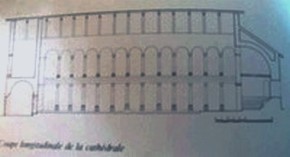 |
|---|
Martyrion of Apostle Philip ; The imposing remains of the martyrium constructed in the first half of the 5th century in memory of St. Philip can be seen on slightly higher ground just outside the city defence walls.The efforts of St. Philip resulted in the foundation here of one of the first Christian communities and one of the first Christian churches. After Philip's I crucifixion by the Romans in 80 his son continued the work of proselytism. Although it would seem reasonable to assume that St. Philip was buried on the site of the ruins of this martyrium no trace has been found of his grave. The martyrium itself is an octagonal structure on foundations measuring approximately 20 x 20 m. Access to the martyrium is afforded by a monumental flight of steps leading up to the building on the side towards the city... |
|---|
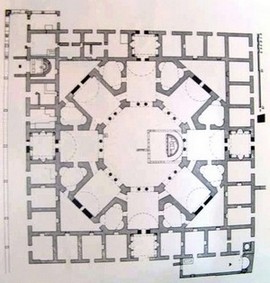 |
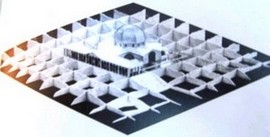 |
|---|

PAMUKKALE THEATRE : The most interesting of all the sites in Hierapolis, after the Pamukkale travertines, is undoubtedly the ancient theatre. Although rather smaller than other specimens that have survived in equally good condition it is well worth careful examination on account of its beautifully preserved marble reliefs. Although at first glance its location on the slope of a hill gives the impression of a Greco-Roman structure, its method of construction, employing vaults and arches, is typical of the Roman period. It is 91 meters high. The theater's construction was started in 62 A.D. after the earthquake of 60 AD in the Flavius era. However, it was not completed in the Hadrian era. It was finally completed in the Severus Era in 206 A.D. The cavea is separated into 7 parts by 8 steps, and there are 50 seats. The Diozoma (a kind of passage) is in the middle of the cavea with a vomitorium with 2 vaults.Although, according to some sources, it could hold over 10,000 spectators, the most optimistic estimate would give no more than 8,500. |
|---|
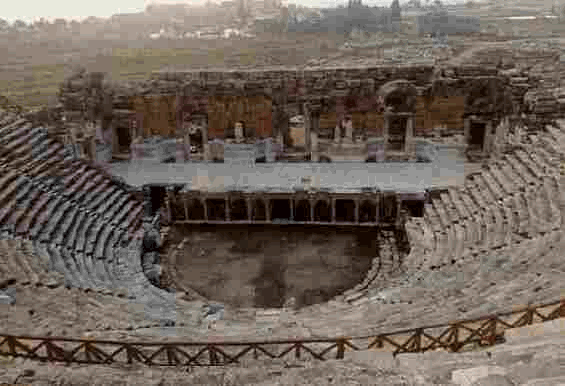 |
| In the middle of cavea was the imperial lodge and the stage (skene) building was decorated with spiral columns and niches with the statues of gods, goddesses, and Roman Emperors. Construction of the theatre was begun under Hadrian in the first half of the 2nd century, but was completed only about a hundred years later during the reign of Septimus Severus. The cavea is divided by eight stairways set at regular intervals, with twenty tiers of seats up to the level of the diazoma and twenty-five tiers above it. |
 |
The facade of the stage building is an exquisite example of the art of Stone carving and is adorned with carvings in high relief of a very high plastic and artistic quality.Although these relief mainly represent mythological stories related to Apollo, the large number of ornaments in the form of oyster shells are reminiscent of Aphrodite. A large number of the reliefs unearthed during the archaeological excavations carried out in the theatre are exhibited in the local museum in the Roman baths. The marble artifacts are scattered over a wide area in front of the theatre include a number of very interesting masks and other decorative elements.There are 10 columns in front of the kingdom box and orchestra, which are 3.66 meters high. The front door of the scene has 5 gates and 6 niches. The niches are behind the columns which are decorated with oyster shells and among the columnsadorned with statues. Many statues were found during the excavations. There are marble embossments on the wall which is behind the scene... |
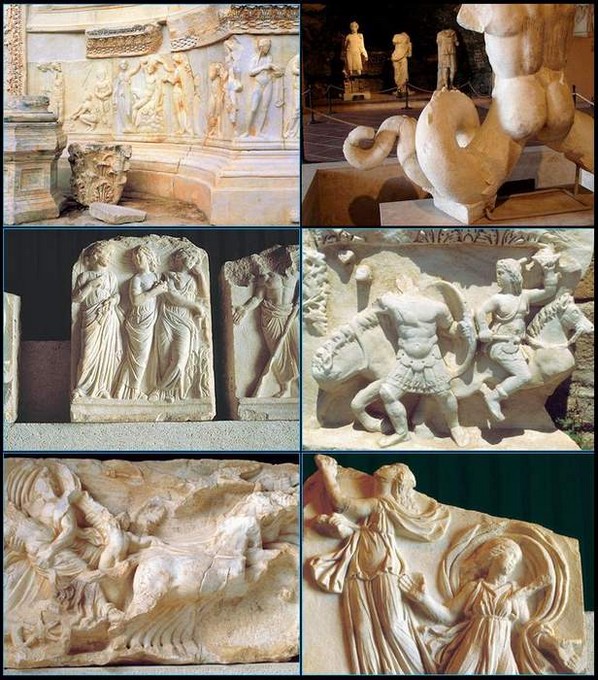 |
| The Legends :THE APOLLO MARSYAS GROUP Originally this work was of the Hellenistic period. However, the figures of Marsyas, begin of Roman style indicate that these are two works that have been made into one. In the relief, Marsyas holds his arms up, his hans tied to a pine tree. Opposite the bound Marsyas a skeleton on its knees is sharpening a knife on a large stone. The row of figures look at the bound figure of Marsyas opposite them. The god Apollo watches from behind. According to the myth Marsyas challenged Apollo to a musical contest. In the event the judges appointed Apollo as the winner and Marsyas the looser. Marsyas was punished for his audacity in challenging Apollo to a musical contest by being condemned to be flayed, for which duty a skeleton was found. The original of the work was executed between the first and the relief depicting the aftermath of Apollos victory is bordered by Delphinios accompanied by two nymphs. Apollo, the palm of victory in his hand, drinks to his triumph.
THE BIRTH OF ARTEMIS AND APOLLO Apollo and Artemis are the children of Leto and Zeus. These two gods, because of their supposed origins in Anatolia, they supported in Anotolian side. And also in the Turuva wars, were particularly worshipped in that region. According to the myth, Leto, pregnant by Zeus,afraids from his wife Hera,so she gave birth on the Delos island. Up to the broad belief, Leto gave birth Artemis in Klaos close to İzmir and hide there. Becaouse of this reason Artemis supported in Ephesus as Had Godess. İt is broadly belief that Apollon was born in Patara in Likya region. In the relief, Leto lies down to the bed to give birth Apollon. Housemaids helpig to her to birth. When the Artemises birth young girls (Horai) were watching the birth with lavander flowers and opium pods on their hands.THE STRUGGLE BETWEEN HERACLES AND ANTIOS Antios was a giant who is the son of the sea-god Poseidon and the mother figure Gaia. Antios joined battle with the Macedonian giants. According to the myth it was impossible to beat Antios down, for wherever he fell he drew strength from his mother earth, Gaia and stands up again. And so, Heracles took Antios on his back, bore him to another land and killes him there.THE NIOBE LEGEND The Niobe Legend is special to Anatolia. Niobe was born in Sipylos (Manisa) where her dad is the King. She grew with Goddess Leto and they had a friendship. Then she married with Amphion,the king of Thebai and she had 12 children, 6 doughter and 6 son. This legend is issues that Niobe has so many children. Niobe thought that she is similar with Leto and she was proud of having one dozen children. When Apollon and Artemis saw that their mother so sad because of this event, they became angry to Niobe. And they killed all of Niobes children. Because of the sadness of loosing her children, Niobe became a stone. The Niobe Legend is still living in Manisa region. In that city there is a Stone that seems as a human face and a little water runs from this stones two eyes shaped hallows.THE LEGEND HADES ABDUCTS PERSEPHONE Persephone is the dougter of Zeus and Demeter. According to the Mythology, while Persephone was picking flower on country, suddenly the ground bursts and God Hades comes by his wheel than he catches Persephone and abducts her to the underground. Demeter looks for her doughter Persephone everywhere but she cant find her. In the end, Helios, the Sun God, shows Demeter where Persephone is. Because of Persephone, abducted to the underground, famines started, abundance of the ground finished and every season became winter. Persephone ate the pomegranate vegetable which given by Hades and connected to the God by charm. After this event, the had God Zeus became mediator and agreed with Hades. Up to the agreement, half of the year (florescence and bearing times), Persephone will be on ground with Demeter. In the other part of the year Persephone will be near her husband Hades. With this mythology associated with the event Hades abducts Persephone with the event seasons being. |

The temple of Apollo ; dated in the late Hellenistic Period, but the rest of the temple in the 3rd century A.D, is located on a slope between the sacred pool and the theatre. The temple, which faces southwest, is reached by a flight of steps. The front of the building rests on a podium 2 m in height while the rear rests on the native rock. The discovery of this temple of Apollo was one of the most remarkable achievements of the Italian excavation team. The first thing to be revealed in the excavations carried out in the southern section of the remains, which were almost entirely buried under the soil, was the Plutonium, consisting, as Strabo had described it, of a fissure located behind the temple. Here they found a chamber and behind this, flowing out very rapidly from the fissure, there emerged a stream of water giving off a very pungent- smelling gas. The chamber was entered by descending three steps land passing through an arched door. In view of the fact that Strabo, in describing the Plutonium, made no mention of any building, it would appear that the temple must have been constructed at a later date. The temple of Apollo is a comparatively short structure 18 m long and 15 m wide! consisting of a pronaos and a cella with, apparently, a row of six columns in front. In view of the fact that the building is largely constructed of spolia and that the site had previously been occupied by an older temple or other building, probably belonging to as early as the Hellenistic period, the present remains cannot be older than the 3rd century A.D. In the course of the excavations it became apparent that the gas rising from the Plutonium caused a certain discomfort. A solution to this was found in ancient times by arranging for the gases to escape at the sides through 2 inch openings between the blocks forming the foundation of the temple. This expedient is particularly evident on the side towards the podium.Various inscriptions can be seen on the stone blocks of which the temple is composed. Of these, the one in northern corner of the cella refers to a plague epidemic, probably the great plague which affected the whole of the Empire in the 2nd century during the reign of Marcus Aurelius. As in all such cases, people were strongly advised to offer votive oferings to the gods, and, of course, to Clams Apollo in particular. An interesting thing here is the following declaration from the mouth of the god: "For you are descended from me and from Mopsus, the founder of the city." Mopsus, who possessed the gift of being able to foretell the future, was a hero who settled in Claros after the Trojan War (l2.13. century B.C.). Although the idea that a city generally thought to have been founded in the Hellenistic period was in some way connected with a personage who lived in so much earlier a period would appear to merit little credence, it is quite clear that this was a belief generally held in the city itself. Mopsus is represented on the coins minted in Hierapolis,and he was also connected with Torrhebus,another mythical personage. |
|---|
 |
| Chaired by Ord.Prff.Dr. Francesco D'Andria the excavation team has found 4 m height of the headless statue of Apollo. That is seen between the classical era masterpieces. According Him , "on the back of the statue, the sculptor did not show the same care and it was placed against a wall and tells that a potential was seen only from the front." Head of statue is expected to be found. |

Plutonium: The Apollon temple was built nearby a cavern known as Plutonium which once had a religious significance. The oldest religious center of the local people is the place where Apollon met the mother goddess, Kybele (Mother Goddess). According to ancient sources the priests of Kybele cult used to walk inside this cavern and ever effected by the poisonous gas."The Plutonium cave is a fissure wide enough for a person to enter. It is very deep. An area of some 30 ft in width surrounded by a fence is covered by a thick mist which makes it impossible to see the actual place. The air outside the fence is quite clear, and when no wind is blowing there is no danger in approaching it, but any living creature who enters dies on the spot.Large animals that enter the fissure immediately collapse and are brought out as corpses.We sent birds in as an experiment and saw them drop dead immediately on entering. Only the eunuchs of the temple of Kybele are able to spend a short time within the cavern without being affected." An annex concealed the entrance to the underworld, the Plutonium. Asclepiodotus, who visited the region in the fifth century, attempted to reach the source of the water by tying a bandage around his nose and mouth and making his way against the now of the stream, but a sudden increase in the depth of the water prevented him from proceeding beyond a certain point. In the 2nd century it was converted into a tourist centre where food and drink was sold to the visitors. Later, a temple was built here and the site of the Plutonium assumed its present-day appearance... |
|---|
NYMPHEUM ( MONUMENTAL FOUNTAIN ) : Monumental Fountains were also called Nypheums after the mythological water fairies, (Nymphs). These fountains were built mainly for the ornamentation of streets and for public use. Two major fountains are located on the main street and another one is situated inside the temenos (sacred precinct) of Apollo temple. The latter has a horse shoe shaped, two storied corinthian order plan. Between the columns there used to stand statues and in front there is a rectangular basin Nymphaeum.The Nymphaeum is located inside the sacred area, in front of of the Apollo temple. It dates from the 2nd century. It was a shrine of the nymphs, a monumental fountain distributing water to the houses of the city via an ingenious network of pipes. The Nymphaeum was repaired in the fifth century during the Byzantine era. The retaining wall was built with elements from the peribolos of the Apollo temple. By doing so, the early Christians cut off the view of the pagan temple. Now only the back wall and the two side walls remain. The walls and the niches in the walls were decorated with statues. The Italian archaeological team has excavated two statues of priestesses, which now on display at the local museum.The Nymphaeum has a U-shaped plan.. |
|---|
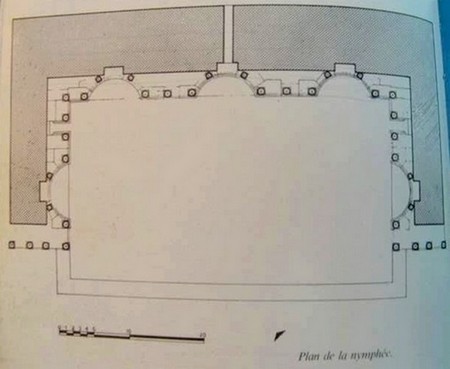 |

Antique Pool- Cleopatras Pool : Especially in The Roman Empire period, Hierapolis and its side was exactly a health centre. In those years, thousands of people used to come to the baths, of which there are more than 15, and they found their remedy in those baths. Todays Antique Pool was shaped by the earthquake which happened in the 7th century AD. The marble portico with Ionic arrangement fell into the spring during the earthquake in the 7th century. According to research, the Antique Pool's water is good for heart diseases, atherosclerosis, blood pressure, rheumatism, eye and skin diseases, rickets, nervous disorders, nervous and physical exhaustion circulatory problems and furthermore when it has been drank it is good for digestive maladies. And all this benefits shows why so many health centers had been founded sides the Antique Pool from Roman Empire times on. The water in the thermal pool is 36-57 C°, pH value is 5,8 and radon value is 1480 pCi/l. Spa water has its inside bicarbonate, sulphate, carbon dioxide, partly with iron and radioactive combination. And also, the water in this spring is suitable for taking shower and drinking cures, 2430 MG/liter melt metal value... |
|---|

MUSEUM-BATH*** The building in Which the local museum is housed consists of Roman baths dating from the 2nd century A.D. It is in an excellent state of preservation and, with its vaults and arches, displays all the characteristic features and beauty of Roman architecture. The plan is typical of other Roman Baths. There is a large court at the entrance, large halls on both sides, a rectangular enclosed area, and the actual bathing area. Two large halls within the Palaestra (sports arena) were reserved for the Emperor's use and for celebrations. The bath consists of three rooms, now used as the salons of the museum: the caldarium, or hot room; the tepidarium, or warm room; and the frigidarium, or cold room. This extremely imposing building is constructed of stone blocks of a considerable size and weight and, with its vaults and arches, gives a very clear idea of the massive strength of Roman architecture. |
|---|
| Unfortunately, it has suffered a great deal of damage from earthquakes and the north wall can be seen to be leaning very precariously to one side. At the present day, the palaestra is used for the exhibition of a number of objects found at various places in the course of the excavations... |
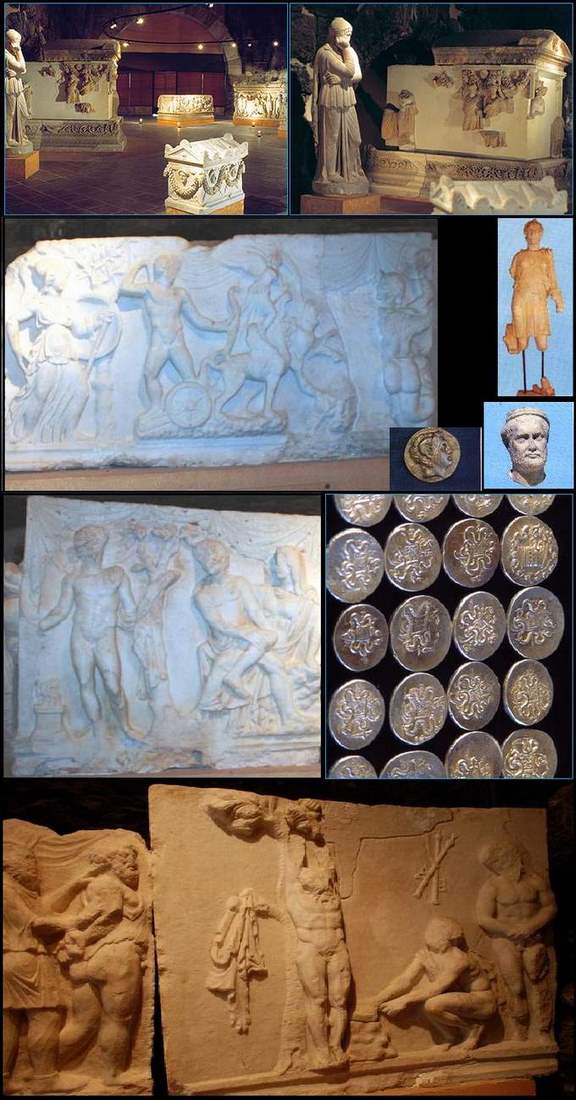 |
The Legends: THE APOLLO MARSYAS GROUP ; Originally this work was of the Hellenistic period. However, the figures of Marsyas, begin of Roman style indicate that these are two works that have been made into one. In the relief, Marsyas holds his arms up, his hans tied to a pine tree. Opposite the bound Marsyas a skeleton on its knees is sharpening a knife on a large stone. The row of figures look at the bound figure of Marsyas opposite them. The god Apollo watches from behind. According to the myth Marsyas challenged Apollo to a musical contest. In the event the judges appointed Apollo as the winner and Marsyas the looser. Marsyas was punished for his audacity in challenging Apollo to a musical contest by being condemned to be flayed, for which duty a skeleton was found. The original of the work was executed between the first and the relief depicting the aftermath of Apollos victory is bordered by Delphinios accompanied by two nymphs. Apollo, the palm of victory in his hand, drinks to his triumph. THE BIRTH OF ARTEMİS AND APOLLO Apollo and Artemis are the children of Leto and Zeus. These two gods, because of their supposed origins in Anatolia, they supported in Anotolian side. And also in the Turuva wars, were particularly worshipped in that region. According to the myth, Leto, pregnant by Zeus,afraids from his wife Hera,so she gave birth on the Delos island. Up to the broad belief, Leto gave birth Artemis in Klaos close to İzmir and hide there. Becaouse of this reason Artemis supported in Ephesus as Had Godess. İt is broadly belief that Apollon was born in Patara in Likya region. In the relief, Leto lies down to the bed to give birth Apollon. Housemaids helpig to her to birth. When the Artemises birth young girls (Horai) were watching the birth with lavander flowers and opium pods on their hands. THE STRUGGLE BETWEEN HERACLES AND ANTIOS Antios was a giant who is the son of the sea-god Poseidon and the mother figure Gaia. Antios joined battle with the Macedonian giants. According to the myth it was impossible to beat Antios down, for wherever he fell he drew strength from his mother earth, Gaia and stands up again. And so, Heracles took Antios on his back, bore him to another land and killes him there. THE NIOBE LEGEND The Niobe Legend is special to Anatolia. Niobe was born in Sipylos (Manisa) where her dad is the King. She grew with Goddess Leto and they had a friendship. Then she married with Amphion,the king of Thebai and she had 12 children, 6 doughter and 6 son. This legend is issues that Niobe has so many children. Niobe thought that she is similar with Leto and she was proud of having one dozen children. When Apollon and Artemis saw that their mother so sad because of this event, they became angry to Niobe. And they killed all of Niobes children. Because of the sadness of loosing her children, Niobe became a stone. The Niobe Legend is still living in Manisa region. In that city there is a Stone that seems as a human face and a little water runs from this stones two eyes shaped hallows. THE LEGEND HADES ABDUCTS PERSEPHONE Persephone is the dougter of Zeus and Demeter. According to the Mythology, while Persephone was picking flower on country, suddenly the ground bursts and God Hades comes by his wheel than he catches Persephone and abducts her to the underground. Demeter looks for her doughter Persephone everywhere but she cant find her. In the end, Helios, the Sun God, shows Demeter where Persephone is. Because of Persephone, abducted to the underground, famines started, abundance of the ground finished and every season became winter. Persephone ate the pomegranate vegetable which given by Hades and connected to the God by charm. After this event, the had God Zeus became mediator and agreed with Hades. Up to the agreement, half of the year (florescence and bearing times), Persephone will be on ground with Demeter. In the other part of the year Persephone will be near her husband Hades. With this mythology associated with the event Hades abducts Persephone with the event seasons being. |

PALESTRA-GIMNASIUM To the east of the building lies a palaestra measuring 35 x 50 m where, in Roman times, young people or those of a sportive nature could practise various sports in order to warm up and start the body sweating. It was also used as a training ground for athletes, and as a venue for certain ceremonies.. |
|---|
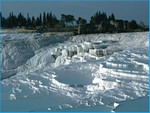
Pamukkale's terraces are made of travertine, a sedimentary rock deposited by water from the hot springs.In this area, there are 17 hot water springs in which the temperature ranges from 35 °C (95 °F) to 100 °C (212 °F). The water that emerges from the spring is transported 320 metres (1,000 ft) to the head of the travertine terraces and deposits calcium carbonate on a section 60 to 70 metres (200 to 230 ft) long covering an expanse of 240 metres (790 ft) to 300 metres (980 ft). When the water, supersaturated with calcium carbonate, reaches the surface, carbon dioxide degases from it, and calcium carbonate is deposited. The depositing continues until the carbon dioxide in the water balances the carbon dioxide in the air. Calcium carbonate is deposited by the water as a soft jelly, but this eventually hardens into travertine.This reaction is affected by the weather conditions, ambient temperature, and the flow duration. Precipitation continues until the carbon dioxide in the thermal water reaches equilibrium with the carbon dioxide in the atmosphere. Measurements made at the source of the springs find atmospheric levels of 725 mg/l carbon dioxide, by the time this water flows across the travertines, this figure falls to 145 mg/l. Likewise calcium carbonate falls from 1200 mg/l to 400 mg/l and calcium 576.8 mg/l to 376.6 mg/l. From these results it is calculated that 499.9 mg of CaCO3 is deposited on the travertine for every liter of water. This means that for a flow rate of 1 ı/s of water 43191 grams are deposited daily. The average density of a travertine is 1.48 g/cm3 implying a deposit of 29.2 dm3. Given that the average flow of the water is 465.2 l/s this implies that it can whiten 13584 m2 a day, but in practice this areal coverage is difficult to attain. These theoretical calculations indicate that up to. 4.9 km2 it can be covered with a white deposit of 1 mm thickness.. |
|---|

GIMNASIUM AREA; To the east of the building lies a palaestra measuring 35 x 50 m where, in Roman times, young people or those of a sportive nature could practise various sports in order to warm up and start the body sweating. It was also used as a training ground for athletes, and as a venue for certain ceremonies... |
|---|












